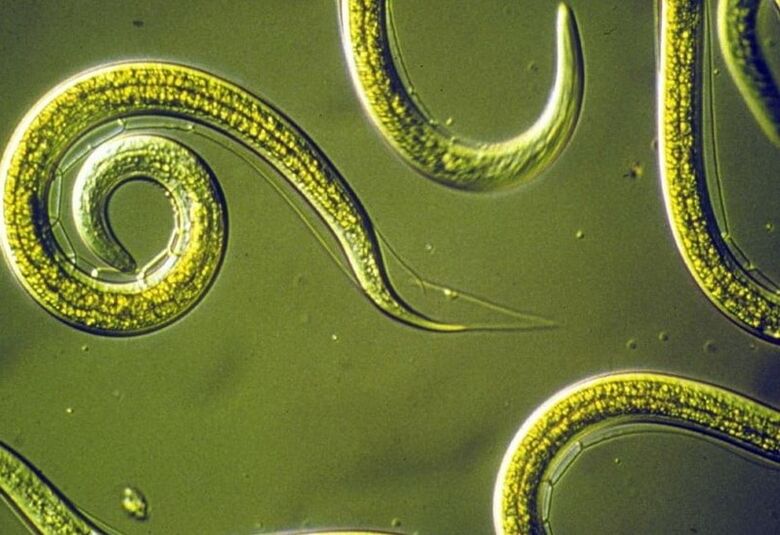Unfortunately, even in modern advanced times there is a risk of infection with helminths. To be able to treat and prevent this phenomenon, it is necessary, at least, to familiarize yourself with the main types of worms.
Types of worms
In medical sources, where you can find answers to questions about what kind of worms a person has, they provide data about different types. Of course, certain types are the most common. According to classification, they can be divided into 3 main types. These are: round and tapeworms, as well as worms.
roundworm
The first in the list of types of worms in humans is to show roundworms. They are also known as nematodes. They got their name because of the body structure, because if you make a cross section of an individual, you can see the resulting roundness. Although there are more than 20 thousand of their species in the world, only a small number of them are usually found in humans.
The most common roundworms include:
- Ringworm. This worm is quite large in size. Its length can reach half a meter. The width varies between 4-5 cm. The color is usually pink, but in different cases it can be whiter or redder. These helminths are localized mainly in the small intestine, but in rare cases, they can also be in the bile ducts. Larvae at the same time quite easily move around the body, through the bloodstream. Their final destination is the lungs. This is where there are the most comfortable conditions for their maturation, because this type of parasite belongs to anaerobes. As they become more viable, they move into the intestines. Ringworms have a long lifespan, which is 12-14 months. Outside the human body, these worms live in the soil, where they lay several thousand eggs every day;
- pinworms. Often found in children, as the cause of infection can be less hand washing or products. A little less often they enter the body with dust particles. Their size is much smaller than roundworms. Males reach 3 mm in length, and females - up to 13-14 mm. The color is completely white. Their favorite habitat is the early part of the large intestine. Eggs are laid in the anus, closer to the anus. Their lifespan is also much shorter than that of roundworms, and is only a few months.
- Trichinella. These medium-sized worms, which reach only 4 mm in length, most often enter the living human body as part of infected meat. Larvae live in muscle tissue, especially in oculomotor and masticatory tissue, but adults prefer to live in the intestine. Trichinella is a danger to humans, because without proper treatment it can be fatal.

tape worm
Tapeworms are characterized by a flat body structure and the complete absence of a gastrointestinal tract. The length of individuals can reach several meters, because they look like long ribbons. They prefer to live in the intestine or gastric tract. Among them are the following types:
- Bull tapeworm. This is one of the largest types of tapeworms. The length of an individual can reach 15-20 meters. The worm attaches to the surface of the small intestine and begins to absorb substances necessary for a person. Without proper diagnosis and treatment, he can live up to 10 years. Infection usually occurs by eating contaminated and undercooked meat;
- Dwarf tapeworms. It got its name because of its small size, which is an average of 4-5 mm. You can get infected with such tapeworms through vegetables that are not washed well, and also dirty hands;
- Wide ribbon. Another great view. The length can reach 10 meters, the width is usually larger than other worms. The larvae enter the body with the infected fish and grow into adults in just 3. 5 weeks. Lives primarily in the small intestine. Lifespan can reach decades;
- Echinococcus. Small worms, their length, as a rule, no more than 5 mm. Infection occurs from infected animals: cats and dogs. This species differs in that individuals are not localized in the intestine, but in the lungs or liver. They are dangerous because they can trigger the formation of cysts, which then require surgical removal.
These worms can be very harmful to the body, so the sooner they are detected, the better.
flukes
Flukes, like tapeworms, are flat parasites due to their body structure. They are also called liver worms, because their main habitat is the liver and bile ducts. Their main types are:
- Fluke. Also known as fluke cats. It lives mainly in rivers and lakes, which means it enters the human body together with infected fish that has undergone poor processing. Pets can act as carriers. Individuals are quite small and rarely reach 12-13 mm. In a person they can live in any organ;
- Chinese or oriental fluke. It is characterized by a transparent red color of the body and a small size, no more than 2. 5 cm, it enters the human body, similar to a normal coincidence. It can lay more than 3. 5 thousand eggs per day;
- Fasciola. These are larger flatworms, they can reach 5-7 cm in length. It is only viable in freshwater conditions. It died in the salt water. A person can become infected with fasciola by drinking contaminated raw water, for example, while bathing, and also by eating plants. The risk is particularly high if it is an aquatic or wild species.
Liverworms, despite their small size, can be dangerous to humans. Patients, in addition to standard symptoms, may experience fever.
The simplest organism
The simplest organisms have existed on earth for millions of years. To date, science reads more than 14. 5 thousand species. Like other parasites, their favorite habitat is soil, water in reservoirs and, of course, the human body. They can stay on the surface of vegetables and fruits for some time, their use often causes infection.
In most cases, when infecting a person with protozoa, it is Giardia in question. Their vitality is enviable. They withstand even the worst environmental conditions.
In their structure, they are distinguished by the presence of four pairs of flagella and a special disk that performs the suction function. Because of them, Giardia must cling to the inner surface of the intestine and begin to become a parasite.
Manifestation symptoms
The fact that worms appear in the human body can be understood by a large number of signs. But most of them are general in nature, indicating the presence of an inflammatory process. This can confuse the patient, forcing him to look for other causes of the disease.
So, the patient can observe in himself during this period:
- Fatigue, lethargy, weariness;
- Pale skin;
- Dizziness and sometimes headache;
- Increased anxiety, irritability. In children, significant aggression can be seen;
- Sleep impairment. Usually worried about insomnia;
- Pain in the joints, pulling sensations in the muscles;
- Increased salivation.

Fatigue is one of the signs of the presence of worms.
The following signs, reminiscent of an allergic reaction or a disease of the gastrointestinal tract, can confuse the patient:
- Yellowing of the skin;
- Rash on the body;
- Bronchial asthma attacks;
- Stool disturbances: constipation or diarrhea;
- Bloated stomach;
- Nausea, as well as vomiting;
- Pain in the stomach and hypochondrium;
- Body temperature rises slightly.
But the more typical symptoms for this condition, which make people most often start to suspect that they have parasites, are:
- Weight loss for no apparent reason. At the same time, it becomes very difficult to return the kilograms that have been left behind;
- Itching in the anus;
- Bruxism. This phenomenon is expressed in teeth grinding during sleep.
Although there are many signs of the presence of parasites in the body, sometimes this phenomenon is completely asymptomatic, and therefore, people may not notice it for months.
Diagnostics
To identify helminths in the body is not easy at all. The standard procedure in this case is to check the stool for worm eggs. I must say that sometimes to detect worms in feces, it may be necessary to take the analysis from 3 to 5 times.
How to identify a certain type of worm, only a doctor knows. It is impossible to do this yourself without test results. Depending on the symptoms present, the doctor may prescribe the following examination procedures:
- Blood analysis. In this case, the number of indicators such as protein and eosinophils are analyzed;
- Analysis of scrapings from the anus;
- Vaginal scraping analysis.
Also, in some cases, additional steps may be required. Such as:
- Sputum examination;
- Study of the composition of urine and bile;
- endoscopy;
- CT scan;
- Ultrasound procedure.
After the parasite is identified, the doctor formulates a treatment plan.
Treatment
Self-treatment of parasites is not allowed. This is due to the following factors:
- The preparation contains different active ingredients, which means it has an adverse effect on various types of helminths;
- Some drugs are only able to destroy worm larvae, but not adults;
- All drugs have some side effects.
In this case, it is necessary to choose a drug based on the results of the diagnostic procedure.
The preparation may have the following active ingredients:
- mebendazole. It only affects worms from the genus pinworms;
- Diethylcarbamazine. Medicines based on it are prescribed if there are filaria in the patient's body;
- Levamisole. Has a wide spectrum of action. Destroys both pinworms and roundworms, as well as other worms;
- Hydroxysinaphthoate bephenia. Effective against roundworms;
- Albendazole. Necessary in the treatment of diseases caused by echinococci;
- Piperazine adipate. It is used to remove roundworms and pinworms from the body.
Traditional medicine also does not rule this out. It offers various means that may not always be able to completely clean the body of parasites, but, at least, can slow down their reproduction and development.

Examples of such methods are:
- Pumpkin seeds. They are taken in their pure form or a decoction is made based on them;
- Watermelon seeds. Apply the same to the pumpkin;
- Colored wormwood;
- Tinted with alcohol and wormwood juice;
- Garlic;
- Tansy;
- Sandy immortal.
It is important to pay attention to the fact that before using folk methods, you should get approval from your doctor and, of course, exclude allergic reactions to the components used.
Are worms dangerous to humans?
Worms not only live in the human body, they are really parasites, remove useful substances, and also suck blood. The body experiences a state of intoxication. The result of a long stay of helminths in a person can be negative consequences such as:
- Weakness of the immune system;
- Violation of the gastrointestinal tract. Poor food digestion, the appearance of ulcers;
- Development of allergies;
- cyst formation;
- Damage to the organs in which they live.
And don't forget that some types of parasites are very, very dangerous. Ignoring their presence can lead to the worst results.
Prevention
Most people at least once in their life are faced with worms. Children are especially affected by this. And this is quite reasonable, in addition to the fact that they have weaker immunity than adults, they also often ignore hygiene rules.
In general, methods that help reduce the risk of infection are not complicated at all. They themselves mean:
- Compliance with personal hygiene rules. Hands should not only be rinsed, but also washed with soap;
- Vegetables, fruits, berries must be washed with plenty of water;
- Any meat: livestock, chicken or fish, should be washed well before cooking. Heat treatment must also be careful. It is not worth taking risks and cooking meat with blood if there is no confidence in its quality and safety;
- Periodic antihelminthic prophylaxis in children. It is best to do this in consultation with a doctor;
- Also, livestock and pets are subject to drug prophylaxis. At the same time, there is no difference whether they live in the courtyard of a private house or in the room itself. If a dog or cat eats raw meat, then prevention from worms should be done without fail.
Such a procedure will help not to meet parasites as long as possible.



























